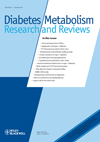Birth weight influences the clinical phenotype and the metabolic control of patients with type 1 diabetes (T1D)
Abstract
Background
High birth weight has been related to an increased risk of type 1 diabetes (T1D), while suboptimal birth weight (both high and low) has been related to obesity, insulin resistance and type 2 diabetes. Insulin resistance, as a consequence of poor metabolic control, has been described in T1D patients. The aims of the study were to analyse the distribution of birth size for gestational age in a large group of T1D patients and to investigate the effect of birth weight on clinical phenotype.
Methods
Six-hundred two Caucasian T1D patients were evaluated. Small for gestational age (SGA) and large for gestational age (LGA) were defined as birth weight at <3rd percentile and >97th percentile for gestational age, respectively. Birth weights between the 3rd and 97th percentiles were defined as appropriate for gestational age. The clinical characteristics of small, appropriate for gestational age and large were compared. Multivariable linear regression models were fitted to evaluate the independent effects of birth weight and other covariates (age at T1D onset, gender and T1D duration) on different clinical outcomes (body mass index, HbA1c, insulin requirement, high-density lipoprotein cholesterol and triglycerides).
Results
Thirteen subjects (2.16%) were small (SGA), and 39 (6.48%) were large (LGA). Daily insulin requirement (U/kg/day) was significantly higher in SGA, while body mass index and HbA1c were increased in LGA. Multivariable linear regression showed a significant negative effect of birth weight on daily insulin requirement (p < 0.001).
Conclusions
Suboptimal birth weight (both high and low) in T1D patients seems to be associated with clinical characteristics suggestive of insulin resistance. Copyright © 2012 John Wiley & Sons, Ltd.




